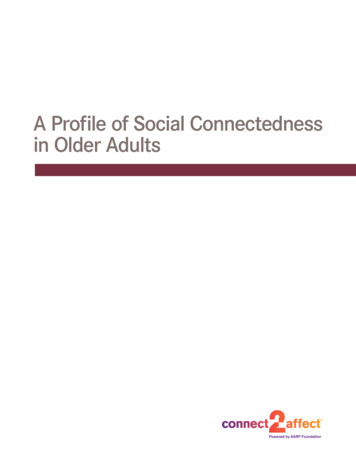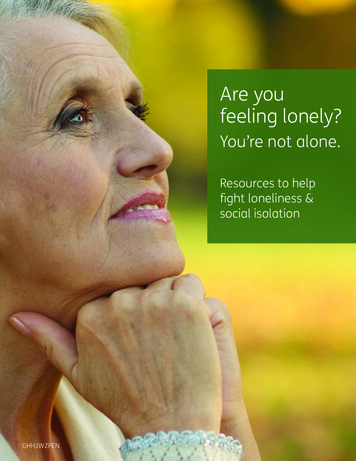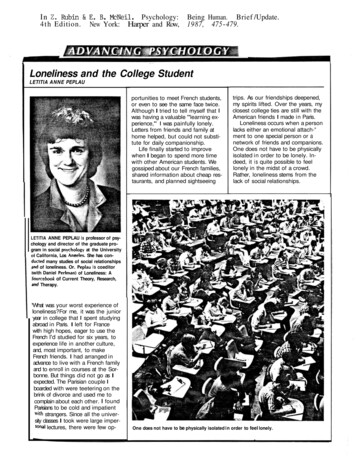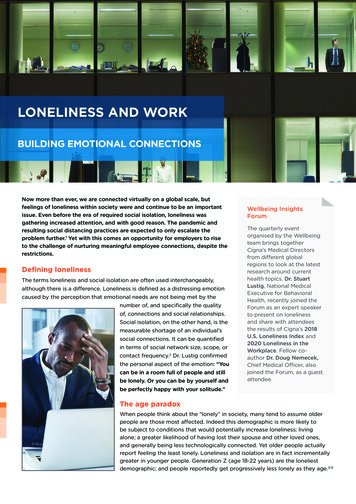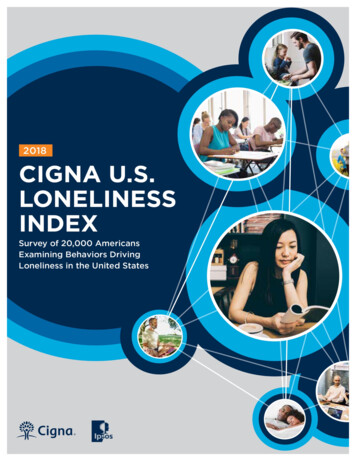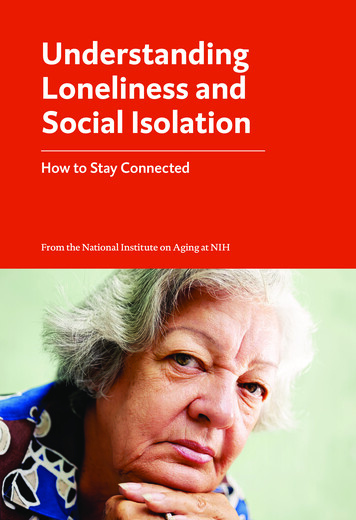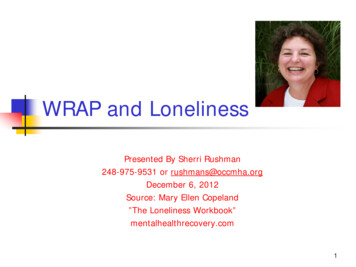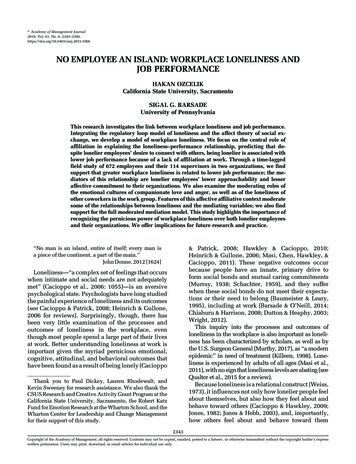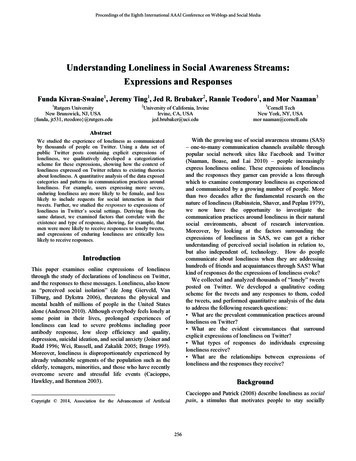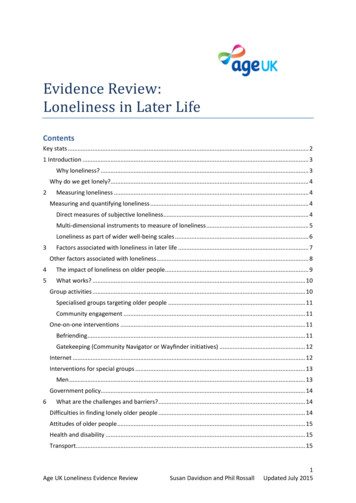
Transcription
Evidence Review:Loneliness in Later LifeContentsKey stats . 21 Introduction . 3Why loneliness? . 3Why do we get lonely?. 42Measuring loneliness . 4Measuring and quantifying loneliness . 4Direct measures of subjective loneliness. 4Multi-dimensional instruments to measure of loneliness . 5Loneliness as part of wider well-being scales . 63Factors associated with loneliness in later life . 7Other factors associated with loneliness . 84The impact of loneliness on older people. 95What works? . 10Group activities . 10Specialised groups targeting older people . 11Community engagement . 11One-on-one interventions . 11Befriending . 11Gatekeeping (Community Navigator or Wayfinder initiatives) . 12Internet . 12Interventions for special groups . 13Men . 13Government policy. 146What are the challenges and barriers? . 14Difficulties in finding lonely older people . 14Attitudes of older people . 15Health and disability . 15Transport. 15Age UK Loneliness Evidence ReviewSusan Davidson and Phil Rossall1Updated July 2015
Flexibility and choice . 157The future . 16What are the future trends? . 16Gaps in the evidence base . 16Scope for future research . 16Appendix A: Social support . 17Sources of social support . 1810 References . 22Key stats Over 1 million older people say they always or often feel lonely.12Nearly half of older people (49% of 65 UK) say that television or pets are their main form ofcompany. 3Loneliness can be as harmful for our health as smoking 15 cigarettes a day.4People with a high degree of loneliness are twice as likely to develop Alzheimer’s as people witha low degree of loneliness.586% of over 65s say they are satisfied with their personal relationships. This is the lowest of allage groups.6Only 46% of over 65s said they spent time together with their family on most or every day,compared to 65-76% for other ages. 12% of over 65s said they never spent time with theirfamily.7Over 65s also spent less time with friends: only 35% spent time with friends most or every day inthe last 2 weeks, and 12% never did.8People who took part in more health-maintaining and independence-maintaining behaviourswere less likely to feel isolated and more likely to feel that their community was a good one togrow old in.9Nearly half (49%) of all people aged 75 and over live alone.109% of older people feel trapped in their own home.116% of older people (nearly 600,000) leave their house once a week or less.1230% say they would like to go out more often.13According to research for DWP, nearly a quarter (24%) of pensioners do not go out socially atleast once a month.14Nearly 200,000 older people in the UK do not receive the help they need to get out of theirhouse or flat.1517% of older people have less than weekly contact with family, friends and neighbours.1611% have less than monthly contact.1741% of people aged 65 and over in the UK feel out of touch with the pace of modern life and12% say they feel cut off from society.18Age UK Loneliness Evidence ReviewSusan Davidson and Phil Rossall2Updated July 2015
1 IntroductionThis review is a summary of available evidence from research on loneliness in later life and it isintended to serve as an evidence base and promote discussion on the topic. The review focuses onloneliness in the community.Why loneliness?Loneliness and isolation, or social isolation, are often discussed together and even usedinterchangeably. While they are related, they are distinct concepts.Loneliness can be understood as an individual’s personal, subjective sense of lacking desiredaffection, closeness, and social interaction with others. Although loneliness has a social aspect, it isalso defined by an individual’s subjective emotional state. Loneliness is more dependent on thequality than the number of relationships.Social isolation refers to a lack of contact with family or friends, community involvement, or accessto services.19 20 21It is possible to be lonely but not to be socially isolated - research shows that older people in largehouseholds and care homes are more likely to report loneliness. It is also quite possible to be sociallyisolated but not lonely. Some people who live on their own or in remote places may not feel orreport loneliness.To put it another way, “ an individual may be lonely in a crowd, socially contented while alone.”22Loneliness can be a temporary, recurrent, or persistent (chronic) state but social isolation doesmatter as it can be a risk factor for loneliness.23 24 It also affects a large number of older people:Thirty-six per cent of people aged 65 and over in the UK feel out of touch with the pace of modernlife and nine per cent say they feel cut off from society.25 Half of all older people (about five million)consider the television as their main form of company.26Only 46 per cent of people 65 and over said they spent time together with their family on most orevery day, compared to 65-76 per cent for other ages. Twelve per cent of people 65 and over saidthey never spent time with their family.27 People aged 65 and over also spent less time with friends:only 35 per cent spent time with friends most or every day in the last two weeks, and 12 per centnever did.28Loneliness causes feelings of disconnectedness from others, and not belonging,29 but it is not just anunpleasant experience. Persistent loneliness can have profound impacts on physical and mentalhealth, and quality of life.For example, loneliness can be as harmful for our health as smoking 15 cigarettes a day,30 andpeople with a high degree of loneliness are twice as likely to develop Alzheimer’s as people with alow degree of loneliness.31These issues are discussed in more detail in the ‘Impacts of loneliness’ section below.In our recent studies we have found that the three top concerns of older people were: bodily pain,loneliness and memory loss.32Age UK Loneliness Evidence ReviewSusan Davidson and Phil Rossall3Updated July 2015
Why do we get lonely?Research on twin and non-twin siblings suggests that loneliness is approximately 50 per centinherited and 50 per cent environmental.33 34 This means that a person’s response to environmentaltriggers is only partly due to their social situation, and is also partly due to inherited factors. Thishelps to explain why some people are happy to be alone, and others are not (but otherenvironmental factors such as upbringing also play a role). However, the fact that loneliness is not100 per cent heritable means that it can be affected by changes to environmental conditions (suchas interventions to reduce loneliness).It is thought that loneliness is an adaptive indicator (self-defence mechanism), like pain or hunger,which signals that something is wrong and prompts the person experiencing it to correct theproblem.35Being alone has been (and can still be) a threat to survival because humans depend on one anotherfor food, shelter, security, and so forth. As a highly social species, cooperation is needed to improvesurvival, and this requires trust, communication, planning, and working together.36 Thus, lonelinessmay be essential for species survival, because like thirst and hunger, it prompts the personexperiencing it to try to alleviate it.37 It is when loneliness becomes chronic that it damages healthand well-being.2Measuring lonelinessMeasuring and quantifying lonelinessLoneliness among older people has been quantified in a number of ways, from survey questionsmeasuring subjective loneliness to validated multi-dimensional instruments, as well as making uppart of wider measures of psychological health and well-being. This section discusses the differenttypes of measures that are used in quantitative research.Direct measures of subjective lonelinessSurveys have consistently shown that around 6-13 per cent of older people report that they areoften or always lonely.38 These vary by question asked and methods used, but they are likely tounderestimate the true extent of loneliness. Age UK (unpublished) surveys conducted between 2009and 2015 have ranged from 6 to 10 per cent39 40 and Wave 5 of the English Longitudinal Survey ofAgeing (ELSA) where 8 per cent said they felt often lonely.41Using the ELSA Wave 5 self-reported (often) lonely measure, Age UK has conducted (as yetunpublished) data analysis of the factors associated with loneliness in people in England aged 65 orover.We identified as statistically significant a number of factors. The most important factors were: Health and disabilityBeing widowedLiving aloneAgeAge UK Loneliness Evidence ReviewSusan Davidson and Phil Rossall4Updated July 2015
and were able to weight them by their relative importance, thus allowing us to construct an index.The research also found that - compared to the baseline categories of excellent health, marriedstatus, age 65-74 and a household size of more than one person - someone who reported to be inpoor health is ten times more likely to feel lonely than someone who reported to be in excellenthealth.One can even compare between factors and say, for example, that those who reported to be in poorhealth are 1.7 times more likely to feel lonely than those who reported to be in fair health.FactorHealth poorHealth fairWidowedHousehold size 1Health goodDivorced/separatedage 75-79Odds ratio10.15.93.02.62.91.70.7This has now also been applied to identifying local and neighbourhood areas by their prevalence ofloneliness. This research, applying the ELSA findings to the Census (2011), was conducted by AgeUK’s Chief Economist, Professor José Iparraguirre, and the Office for National Statistics. Age UK cannow identify “hotspots” where the prevalence of loneliness is highest, not only at Local Authoritylevel but now at neighbourhood level.This means that we can identify average prevalence of loneliness at age 65 in the following areas: All 6,971 Middle Layer Super Output Areas in England, which contain an average of about2,500 older individuals (aged 65 ) or 1,000 older householdsAll 32,844 Lower Layer Super Output Areas (roughly 500 older people) andAll 171,372 Output Areas in England (about 70-80 older people or 28-30 older households)Age UK Research expects to publish a methodology paper for the ELSA research and also one, jointlywith ONS – on the local statistics shortly.Forthcoming research will explore the longitudinal aspects of loneliness, (changes over time) andgive a clearer idea of transitions into and out of loneliness and the prevalence of sustainedloneliness.42Multi-dimensional instruments to measure of lonelinessDe Jong-Gierveld Loneliness ScalesFirst published in 1985, the De-Jong Gierveld scale is an instrument for measuring loneliness, basedon an 11 point scale.43 Measuring subjective loneliness by drawing on a cognitive approach, this isbased on two types of loneliness – emotional and social.Age UK Loneliness Evidence ReviewSusan Davidson and Phil Rossall5Updated July 2015
A six-item version of the scale was published in 2006 to make it easier to include in surveys wherethere is insufficient space for the 11 item scale.44 This version of the scale has been usedinternationally by the United Nations.UCLA Loneliness ScalesAnother commonly used instrument for measuring loneliness is the UCLA Loneliness Scale, namedafter the University of California, Los Angeles, where it was originally developed to measureloneliness among college students. It was based around statements made by lonely people todescribe their experience. First published in 1978, the most recent is the third version published in1996.45 This version included wording revisions specifically designed to make it easier to administerin surveys of older people. The full version of the UCLA scale contains 20 items.A three-item version of the scale was developed by Hughes et al from the University of Chicago foruse in the 2002 US Health and Retirement Study, and has been replicated in ELSA.46Loneliness as part of wider well-being scalesLoneliness affects an individual’s well-being and is included as a dimension in a number of othermulti-dimensional instruments to measure this, or these include other dimensions which correlateclosely. These include:Ryff Scales of Psychological Well-beingRyff’s scales of Psychological Well-being were designed to measure six theoretically motivatedconstructs of psychological well-being (e.g. autonomy and purpose in life).47 The originalquestionnaire included 120 items, but reduced versions have been developed for between 18-120items. ELSA uses a 43 item version which includes a question on loneliness.CES-D DepressionThe CES-Depression scale is a commonly used scale looking at how the respondent felt over the pastweek, to measure depression. The main version has 20 items. ELSA uses an eight-item version of theCES-Depression scale.48 This includes the question on loneliness in the past week.CASP-19CASP-19 is a wide-ranging measure of quality of life in older age. It covers four domains – Control,Autonomy, Self-realisation and Pleasure.49 It does not measure loneliness but provides data onvariables associated with loneliness (e.g. ‘my health stops me doing what I want to’). It is included inELSA (the English Longitudinal Study on Ageing).WEMWBSThe Warwick-Edinburgh Mental Well-being Scale aims to measure two perspectives ofmental well-being itself. These two perspectives are hedonic perspective (which focuses onthe subjective experience of happiness and life satisfaction) and eudaimonic perspective(which focuses on psychological functioning, good relationships with others and selfrealisation).The appropriate measures should be chosen on the basis of the purpose and problem; it is importantto think about the interpretation of the results and whether the measure is validated.Age UK Loneliness Evidence ReviewSusan Davidson and Phil Rossall6Updated July 2015
From here on, references to loneliness are of older people, unless otherwise stated.3Factors associated with loneliness in later lifeWe are undertaking a research project focusing on factors associated with being often lonely andthe interrelation between factors. We will be undertaking analysis of loneliness prevalence rates byfor example, older people in a/not in a relationship, older age groups, self-perceived health/financialstatus, just to mention a few.Many existing studies, have found the following factors to be correlated with older people sayingthey feel lonely:(Order of list does not reflect the strength of the association with loneliness.) Age Ethnicity and language Sex Living arrangements and marital status Geography Housing Health Income Providing informal care Sexual orientationAge: The likelihood of expressing self-perceived loneliness increases with age.50Gender: Men and women are affected differently: older women are more likely to say they feellonely than older men.51 52Living arrangements and marital status: People who live on their own are more likely to say theyare ‘often’ lonely.53 Sixty-three per cent of adults aged 52 or over who have been widowed, and 51per cent of the same group who are separated or divorced, report feeling lonely some of the time oroften.54 People’s attitudes to death may affect their response to bereavement.55 The experience ofliving alone appears to contribute towards being excluded from social relationships.56Housing: Older people living in residential care report feeling more lonely than those in thecommunity.57Geography: Some studies indicate that living in a rural area correlates with loneliness;58 however,this is a complex issue,59 as various other studies suggest the opposite. For example, one study hasshown that in rural areas, levels of loneliness decrease as population density increases.60 Lonelypeople are more likely to be lonely if they live in a deprived urban area or an area in which crime isan issue.61 And, being widowed and in poor health predicted loneliness in urban areas.62 Age UK’sexploratory analysis of ELSA data63 has found that the incidence of older people who are ‘often’lonely is slightly higher in urban than rural areas, though the difference is slight. More research isneeded to unpick this.Health: Health and disability play a role. Poor health, reduced mobility, cognitive impairment, andsensory impairment increase older people’s chances of being lonely.64 65 66Age UK Loneliness Evidence ReviewSusan Davidson and Phil Rossall7Updated July 2015
Income: A direct correlation exists between low income and loneliness and isolation among olderpeople.67Providing informal care for others: There is no clear evidence of a relationship between theprovision of informal care by older people and risk of being lonely. There is, however, limitedevidence from Sweden that being an older carer is associated with a lower risk of loneliness, ascaregivers in the study had a larger social network than those not providing informal care.68However, a recent report for Carers’ Week 2013 shows that 61 per cent of the carers surveyed foundit difficult to maintain friendships as a result of their caring responsibilities.69 However, this surveywas not specific to older carers, with only 17 per cent of the sample aged 65 or over.Ethnicity and language: There is evidence that ethnic minority elders may be among the mostlonely.70 71Sexual orientation: Gay men and lesbians seem to be at greater risk of becoming lonely and isolatedas they age.72Key transitions, which tend to occur in older age, can also trigger loneliness; these includeretirement, becoming a carer, and bereavement.73 Older people themselves say that they find itmore difficult to create friendships in later life.74Other factors associated with lonelinessThere is evidence that social exclusion plays a role in the reporting of feelings of loneliness. Althoughit cannot be claimed that social exclusion causes loneliness, it was found “that overall exclusion wasa significant predictor of well-being and loneliness.”75 Moreover, evidence from ELSA 2002 and 2008surveys indicates that social exclusion is characterised by seven domains i) social relationships; ii)cultural; iii) civic activities and access to information; iv) local amenities; v) decent housing andpublic transport; vi) common consumer goods; and vii) financial products.76 A comparison of resultsbetween 2002 and 2008 found that experiencing exclusion in three or more of these areas wasassociated with almost a three-fold increase in the risk of becoming lonely.77A related concept is ‘social detachment’, in which people fail to participate in social activities. Alongitudinal study78 of ELSA data suggests four domains of participation: civic participation(membership of political party, trade union, neighbourhood watch, church, volunteering), leisureactivities (education, arts, social or sports club, gym, etc.), cultural engagement (going to cinema, artgallery, theatre, etc.), and social networks (having or being in contact with friends, family, children).The findings demonstrated that majority of older people are not detached from social life. However,a significant number are: 20 per cent detached from 3 or more domains 50 per cent detached from civic participation and leisure activities 5 per cent detached from social networksSocial detachment has similar risk factors for loneliness in later life as those posited above:Age UK Loneliness Evidence ReviewSusan Davidson and Phil Rossall8Updated July 2015
For example, people who were single, separated, divorced or widowed were more likely to be‘detached’ than those living together as a couple. Those who were poorer, unhealthier, or withlower levels of education were more likely to be ‘detached’ from civic, leisure and culturalengagement.Access to public or private transport has a significant impact on engagement/detachment. Barriers inthe environment can contribute to feeling lonely, probably because they reduce mobility; snow andice during winter time, long distances to services, lack of resting places, dangerous crossroads, noisytraffic and high curbs roughly doubled the probability of loneliness.79Our own initial analysis indicates that wealth is the most consistent driver of movement into socialdetachment across domains: poorer individuals are more likely to move into social detachment thanthose who are richer, except in the social network domain.A special example of community engagement is getting people from different generations tointeract. Generally, interaction between younger and older people is low, and the majority of peoplein one study said that different generations find it hard to communicate outside of families.80 Intheory, interventions that support intergenerational interaction could improve communityengagement and reduce loneliness.4The impact of loneliness on older peopleAs noted above, existing health conditions or impairments can lead to a curtailment ofindependence and can limit social roles, resulting in feelings of loneliness.81 Conversely, chronicfeelings of loneliness can result in deterioration of health and well-being, and a shorter lifespan.82Feeling lonely has been shown to increase blood pressure and risk of cardiovascular diseases,83elevate cortisol and stress levels which weakens the immune system,84 impair sleep quality (whichcauses memory problems) leading to negative effects on metabolic, neural and hormonalregulations,85 and heighten feelings of depression, anxiety, and increase vulnerability.86Self-perceived loneliness doubles the risk of developing Alzheimer’s disease.87 88 There is evidencethat loneliness and social isolation are associated with reduced cognitive function,89 while sociallyengaged older people experience less cognitive decline and are less prone to dementia.90 It isthought that cognitive health is facilitated directly through enhanced brain stimulation, andindirectly through lowered stress reactions,91 92 improved coping mechanisms, and healthybehaviours.93Having weak social connections also carries a health risk: those with strong social connections have a50 per cent increased likelihood of survival after an average follow-up time of 7½ years.94 On theother hand, nursing home residents who report feeling emotionally lonely die sooner than thosewho are not.95It has been found that loneliness often relates to feelings of ‘anger, sadness, depression,worthlessness, resentment, emptiness, vulnerability and pessimism’.96Studies have also found that loneliness leads to poor lifestyle behaviours; for example, alcohol hasbeen shown to be used by people in order to alleviate a sense of a meaningless life, depression,anxiety and loneliness.97 98 Studies have also found a link with drug abuse and bulimia and loneliness.Age UK Loneliness Evidence ReviewSusan Davidson and Phil Rossall9Updated July 2015
Lonely adults are more likely to be overweight and smoke,99 and are less likely to exercise.100 There isa proven link between loneliness, depression and suicide.101 102But loneliness does not just directly affect health and well-being; it can also become a vicious circle:research has shown that lonely people are more likely to view social encounters with more cynicismand mistrust,103 104 105 rate others and themselves more negatively, and expect others to rejectthem.106 In addition, lonely people tend to adopt behaviours that increase their likelihood ofrejection.107 These beliefs and behaviours are referred to as ‘maladaptive social cognition’.5What works?There is a lack of robust and reliable evidence on the evaluation of services for older people ingeneral and the evidence collated here is the best available.Research shows that loneliness is not an immutable trait but rather can be improved (or worsened).Interventions that enhance a feeling of social connectedness can alter self and others’ perceptions,improve the quality of social interactions, and reduce feelings of loneliness.Interventions are often categorised in the literature in four ways, as attempts to: improve socialskills; enhance social support; increase opportunities for social interaction; or address maladaptivesocial cognition (defined as behaviour that is counter-productive or interferes with everyday living).A rigorous quantitative meta-analysis108 suggests that certain interventions in all of these categoriescan be effective at reducing loneliness, regardless of age and other characteristics of theparticipants, but interventions that attempt to change maladaptive social cognition are the mosteffective.However, studies of interventions we have found for older people in the UK are only of the type thattry to increase opportunities for social interaction. It may be because these are the easiest and mostcost-effective to implement (for reaching a larger number of people).If schemes to target loneliness in older people are to be effective, they must involve older people atevery stage, including planning, development, delivery and assessment.109 110It has been acknowledged too that interventions are more effective when they are tailored to thetarget group. For instance, one ESRC research study highlighted the crucial role of communitycentres for minority ethnic older women in ‘offering a meeting point for sharing identity, language,culture and experiences.’ 111 112It is worth noting that interventions not specifically targeted at combating isolation and lonelinesscan still have a tangible positive effect on them.113 114Below is a summary of findings about the most common ‘social interaction’ interventions for olderpeople. A discussion about social support networks and sources (but not interventions) is inAppendix A.Group activitiesAge UK Loneliness Evidence ReviewSusan Davidson and Phil Rossall10Updated July 2015
Group interventions target many people at once, so they may be more cost-effective than one-onone interventions. In addition, with a focus on the activity rather than ‘loneliness’, they can avoid anegative stigma and thus attract more participants.Specialised groups targeting older peopleThis is a very broad category,
were less likely to feel isolated and more likely to feel that their community was a good one to grow old in.9 Nearly half (49%) of all people aged 75 and over live alone.10 9% of older people feel trapped in their own home.11 6% of older people (nearly 600,000)
